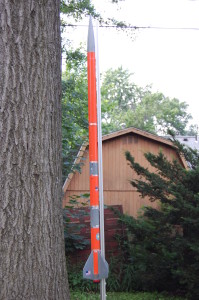Looking into some design changes for project Comanche XR9
Comanche XR9 Launch vehicle modifications.
The Comanche XR9C rocket is born from Project Artemis – The series of four fin based rockets that were used in the bulk of my early experiments in rocketry. This was the first big experimental project that marked my re-entry to the rocketry hobby in 2009.
Side note: The fleet of experimental rocketry designs all bare the “XR” design designation. These experimental rockets are designed to push the envelope in some aspect of hobby rocketry design. The knowledge gained is used in developing advanced features in “standard” rocketry that are intended for routine hobby rocket flights.
Comanche’s four fin design (while being a different physical shape than Artemis has the same effective fin area. One benefit of this was that the Artemis flight data (which was well known at this point) could be compared and applied to project Comanche.
Comanche XR9C proved that performance was indeed very similar to the Artemis series of rockets. Right down to some of the flight restrictions – namely the 12 MPH wind speed limitation.
The wind speed limitation became quite the issue…with many flights being scrubbed. By comparison, One of Project Perseus’ design criteria were being able to fly in a broader range of wind conditions. The Smaller Perseus rockets (Perseus 1 / XR4) were able to fly in wind conditions well over the 20 MPH limit of the rocketry hobby without issue (besides recovery issues).
This ability carried forward into the XR6 (Perseus V) design.
Much of this flexibility seen in the XR4 and XR6 designs is due to the computer aided design of the fins.
The same process was begun for the XR9 design. After several months of testing & modeling in the computer design domain, an updated design designated XR9F is about to be unveiled.
The fin shape of the XR9F is very similar to the XR9C, but “stick out” much less.
Tests are showing that this change allows the XR9F stack to withstand a much broader range of winds than currently experienced.
There are many tests left to do before the new fin design is unveiled…including some tests using entirely different fin shapes in an attempt to attain better stability at flight speeds in the 200 MPH range.
The testing is expected to continue through early 2016.
